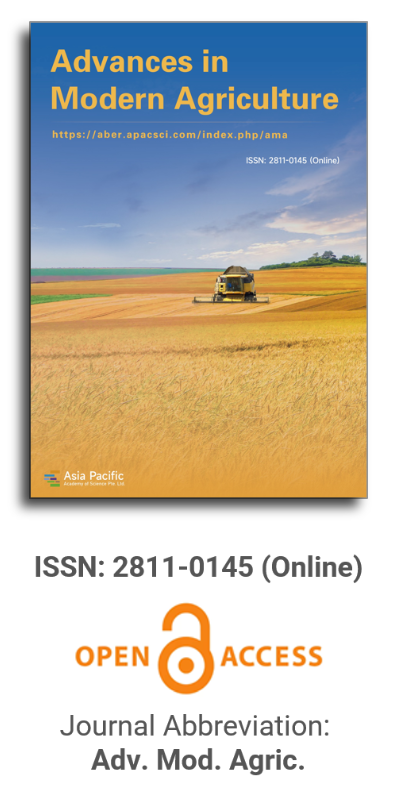


Biostimulants: An innovation in agriculture for the cultivation of coffee (Coffea arabica L)
Vol 4, Issue 1, 2023
VIEWS - 3642 (Abstract)
Download PDF
Abstract
The research was conducted in Jipijapa, in the town of Andil. The objective was to evaluate the physiological and morphological behavior of arabica coffee in the nursery stage with the application of biostimulants: starlite, humega, micorriza, and evergreen, compared to urea. A completely randomized experimental design was applied, using a factorial arrangement of repetitions in time for the morphological variables, and Tukey’s test was applied based on the statistical differences found. The results obtained at the physiological level established a significant difference (p < 0.05) in the variables dry matter, moisture, and nitrogen (N), with starlite and evergreen biostimulants being the best in DM and humega and evergreen in N content. There was a better response to chlorophyll (Cl) assimilation by all biostimulants, surpassing urea in general, with micorriza and starlite being the best, establishing a high positive correlation between N and chlorophyll. In terms of morphological development, Urea showed a better response, and at the biostimulant level, humega and micorriza showed better results, all between 90 and 120 days.
Keywords
References
- Espinoza Alarcón WL, Mosquera Yépez D. Sectoral Analysis of Coffee and Processed Coffee and Its Importance in Ecuadorian Exports, Period 2012–2016 (Spanish) [Bachelor’s thesis]. Universidad de Guayaquil; 2017.
- Alarcón López A. Productive Management Model for Coffee (Coffea arabica L.) Cultivation in Southern Ecuador (Spanish) [Bachelor’s thesis]. Universidad Politécnica de Madrid; 2011.
- Aspiazu Villavicencio K, Navarro Moncayo J. Project for the Commercialization of Bean Coffee (Organic Coffee), Acting as an Intermediary, for Local Consumption in the City of Guayaquil and as an Export Option (Spanish) [Bachelor’s thesis]. Escuela Superior Politécnica del Litoral; 2009.
- Monteros Guerrero A. Yields of dry coffee beans in Ecuador 2016 (Spanish). Available online: https://docplayer.es/29340888-Rendimientos-de-cafe-grano-secoen-el-ecuador-2016.html (accessed on 22 October 2018).
- Venegas Sánchez S, Orellana Bueno D, Pérez Jara P. The Ecuadorian reality in coffee production (Spanish). RECIMUNDO 2018; 2(2): 72–91. doi: 10.26820/recimundo/2.(2).2018.72-91
- Du Jardin P. Plant biostimulants: Definition, concept, main categories and regulation. Scientia Horticulturae 2015; 196: 3–14. doi: 10.1016/j.scienta.2015.09.021
- Díaz Medina A, Suárez Pérez C, Díaz Milanes D, et al. Influence of the biostimulant FitoMas-E on the production of coffee plant (Coffea arabica L.) seedlings. Centro Agrícola 2016; 43(4): 29–35.
- González Vega M, Rosales Jenqui P, Castilla Valdés Y, et al. Effect of Bioenraiz® as a stimulant of germination and development of coffee tree (Coffea arabica L.) seedlings. Cultivos Tropicales 2015; 36(1): 73–79.
- Ormeño MA, Ovalle A. Preparation and application of organic fertilizers. In: Plant Science and Production. INIA Divulga; 2007. pp. 29–31.
- Aguilar Jiménez CE, Alvarado Cruz I, Martínez Aguilar FB, et al. Assessment of three organic fertilizers on coffee (Coffea Arabica L.) in nursery stage. Siembra 2016; 3(1): 11–20.
- Parrales Marcillo G, Castro Piguave C. Determination of the morphological characteristics of 20 varieties of arabica coffee hybrids of high genetic value (Spanish). Available online: https://repositorio.unesum.edu.ec/handle/53000/1280 (accessed on 26 July 2019).
- Provincial Government of Manabí. Canton Jipijapa. Provincial Government of Manabí; 2019.
- De la Roza Delgado B, Martínez Fernández A, Argamentería Gutiérrez A. Determination of dry matter in pastures and forages from drying temperature for analysis (Spanish). Rev Pastures 2002; 32(1): 91–104.
- Selecta JP. Barcelona: Laboratory apparatus factory. Available online: https://grupo-selecta.com/en/?avia_forced_reroute=1 (accessed on 10 October 2019).
- Cofes. Chlorophyll a quantification. Buenos Aires: Federal council of health services entities. Available online: http://www.xn--cofs-dpa.org.ar/downloads/relas/5jomada/4CLO-ROFLA.pdf. (accessed on 1 October 2018).
- Gabriel J, Indaco-chea Ganchozo B, Valverde A, Castro Piguave C. Experimental designs: Theory and practice for agricultural experiments (Spanish). Available online: http://142.93.18.15:8080/jspui/handle/123456789/116 (accessed on 22 October 2018).
- Yakhin OI, Lubyanov AA, Yakhin IA, et al. Biostimulants in plant science: A global perspective. Frontiers in Plant Science 2017; 7: 2049. doi: 10.3389/fpls.2016.02049
- Huang B. Plant growth regulators: What and why. Golf Course Management 2007; 75(1): 157–160. doi: 10.1007/s00572-010-0337-z
- Basak A. Biostimulants: Definitions, classification and legislation. In: Gawroñska H (editor). Biostimulants in Modern Agriculture: General Aspects. Editorial House Wieú Jutra, Limited; 2008. pp. 7–17.
- Bulgari R, Cocetta G, Trivellini A, et al. Biostimulants and crop responses: A review. Biological Agriculture & Horticulture 2014; 31(1): 1–17. doi: 10.1080/01448765.2014.964649
- Russo RO, Berlyn GP. The use of organic biostimulants to help low input sustainable agriculture. Journal of Sustainable Agriculture 1991; 1(2): 19–42. doi: 10.1300/J064v01n02 04
- Karnok KJ. Promises, promises: Can biostimulants deliver. Golf Course Management 2000; 68(8): 67–71.
- Banks JM, Percival GC. Evaluation of biostimulants to control Guignardia leaf blotch (Guignardia aesculi) of horsechestnut and black spot (Diplocarpon rosae) of roses. Arboriculture and Urban Forestry 2012; 38(6): 258–261. doi: 10.13140/rg.2.1.2897.2883
- Hamza B, Suggars A. Biostimulants: Myths and realities. TurfGrass Trends 2001; 10(8): 6–10.
- Jardin PD. The science of plant biostimulants—A bibliographic analysis. Available online: https://www.researchgate.net/publication/288264889_The_science_of_plant_biostimulants_-_a_bibliographic_analysis (accessed on 15 October 2019).
- Torre LA, Battaglia V, Caradonia F. Legal aspects of the use of plant strengtheners (biostimulants) in Europe. Bulgarian Journal of Agricultural Science 2013; 19(6): 1183–1189.
- La Torre A, Battaglia V, Caradonia F. An overview of the current plant biostimulant legislations in different European Member States. Journal of the Science of Food and Agriculture 2016; 96(3): 727-734. doi: 10. 1002/jsfa.7358
- Cenicafe. Physiological and nutritional disturbances of coffee. Available online: https://www.cenicafe.org/es%20/index.%20php/nuestras_publicaciones/cartillas (accessed on 10 October 2018).
- Ramirez Builes VH, Moreno Berrocal AM, Lopez Ruia JC. Early evaluation of nitrogen deficiency in coffee and applications. Available online: http://www.biblioteca.cenicafe.org (accessed on 15 October 2018).
- Tello Gómez E. Effect of the application of biostimulants, foliar fertilizers and kaolin, on the agronomic behavior and production of the rice variety (Oryza sativa) CR-4477 on La Vega farm, San Carlos, Alajuela, Costa Rica (Spainish). Available online: https:// repositoriotec.tec.ac.cr/handle/2238/3321 (accessed on 26 July 2019).
- Sadeghian Khalajabadi S, Gonzales Osorio H. Technical advances: General fertilization alternatives for coffee plantations in the production stage. Available online: https://www. cenicafe.org › publications › avt04241 (accessed on 15 October 2018).
- Aharoni A, Galili G. Metabolic engineering of the plant primary—Secondary metabolism interface. Current Opinion in Biotechnology 2011; 22(2): 239–244. doi: 10.1016/j.copbio.2010.11.004
- Rafiee H, Naghdi Badi HA, Mehrafarin A, et al. Application of plant biostimulants as new approach to improve the biological responses of medicinal plants—A critical review. Journal of Medicinal Plants 2016; 15(59): 6–39.
- Sanclemente MA, Peña EJ. Growth and photosynthetic efficiency of Ludwigia decurrens walter (Onagraceae) under different concentrations of nitrogen. Acta Biológica Colombiana 2008; 13(1): 175–186.
- De Lima Vasconcelos R, de Mello Prado R, Reyes Hernandez A, Caione G. Effect of measurement time, position and leaf portion on chlorophyll indices in potato (Spanish). Idesia 2014; 32(4): 23–28. doi: 10.4067/S0718-34292014000400004
- Sadeghian Khalajabadi S, Salamanca Jimenez A. Micronutrients in coffee fruits and leaves. Ceni-Coffee 2015; 66(2): 73–87.
- Utria Borges E, Rodríguez Oquendo V, Moisés Medina LG, et al. Response of coffee seedlings (Coffea arabica L.) to brassinosteroid application at different concentrations and stages of development (Spanish). Rev Chapingo Ser Hortic 2004; 10(1): 11–14. doi: 10.5154/r.rchsh.2000.12.084
- Acuña P. Influence of foliar fertilizer application at nursery level of arabica coffee (Coffea arabica) in Cabo de Hacha site of Jipijapa canton 2013 (Spanish). Universidad Estatal del Sur de Manabí; 2013.
- University of Lodz. Biostimulators in modern agriculture. Retrieved from: https://usosweb.uni.lodz.pl/kontroler.php?_action=actionx:katalog2/przedmioty/pokazPrzedmiot(prz_kod:0400-BE707D)&lang=2 (accessed on 5 October 2019).
- Przybysz A, Wrochna M, Slowinski A, Gawronska H. Stimulatory effect of Asahi SL on selected plant species. Acta Sci Pol Hortoru 2010; 9(2): 53–64.
- Truba M, Jankowski K, Sosnowski J. The plants reaction on biological preparations treatment. Ochrona Środowiskai Zasobów Naturalnych 2012; 53: 41–52.
Supporting Agencies
Copyright (c) 2023 Valverde-Lucio Yhony, Moreno-Quinto Josselyn, Quijije-Quiroz Karen, Castro-Landín Alfredo, Merchán-García Williams, Gabriel-Ortega Julio

This work is licensed under a Creative Commons Attribution 4.0 International License.

This site is licensed under a Creative Commons Attribution 4.0 International License (CC BY 4.0).

Prof. Zhengjun Qiu
Zhejiang University, China

Cheng Sun
Academician of World Academy of Productivity Science; Executive Chairman, World Confederation of Productivity Science China Chapter, China
Indexing & Archiving
In the realm of modern agriculture, the integration of cutting-edge technologies is revolutionizing the way we approach sustainable farming practices. A recent study published in Advances in Modern Agriculture titled "Classification of cotton water stress using convolutional neural networks and UAV-based RGB imagery" has garnered significant attention for its innovative approach to precision irrigation management. Conducted by researchers from Institute of Data Science and the AgriLife Research and Extension Center of Texas A&M University (authors's information is below). This study introduces a novel method for classifying cotton water stress using unmanned aerial vehicles (UAVs) and convolutional neural networks (CNNs), offering a powerful solution for optimizing water use in agriculture.
Modern agricultural technology is evolving rapidly, with scientists collaborating with leading agricultural enterprises to develop intelligent management practices. These practices utilize advanced systems that provide tailored fertilization and treatment options for large-scale land management.
This journal values human initiative and intelligence, and the employment of AI technologies to write papers that replace the human mind is expressly prohibited. When there is a suspicious submission that uses AI tools to quickly piece together and generate research results, the editorial board of the journal will reject the article, and all journals under the publisher's umbrella will prohibit all authors from submitting their articles.
Readers and authors are asked to exercise caution and strictly adhere to the journal's policy regarding the usage of Artificial Intelligence Generated Content (AIGC) tools.
Asia Pacific Academy of Science Pte. Ltd. (APACSCI) specializes in international journal publishing. APACSCI adopts the open access publishing model and provides an important communication bridge for academic groups whose interest fields include engineering, technology, medicine, computer, mathematics, agriculture and forestry, and environment.



.jpg)
.jpg)

.jpg)
